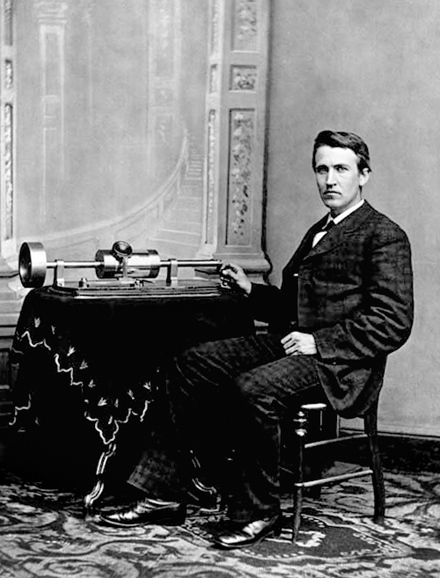What is hi-fi acoustics?
Hi music lovers! Today let's talk about one of the most controversial terms in sound.
For a long time, in the minds of people, Hi-Fi was presented as expensive acoustics for geeks from the world of music - “audiophiles”, to listen to which you need to have good ear for music, but a “regular” user will not hear the difference. In fact, this opinion was formed partly due to the fact that Hi-Fi audio was not available in Russia for a long time, the equipment of well-known brands was brought only from abroad, so high-quality sound was the destiny of the elite. Now, such equipment can be easily purchased in many stores. Hi-Fi has become quite widespread and gradually captures the hearts (and ears) of people.

Let's start with the story. As is known, the invention of the phonograph by Thomas Edison back in 1877 was an important event in the world of sound recording. Now, in order to listen to music at home, it was not necessary to hire musicians or learn to play yourself.

The expression "high fidelity", which in the future was shortened to "Hi-Fi", was first used in 1932 by the English engineer Harold Hartley to advertise his street loudspeakers. High fidelity translates as “high fidelity”, which very accurately conveys the meaning of Hi-Fi audio. The issue of quality and accurate reproduction of a recording has been of interest to people for a long time, for example, in the 19th century, recording was considered high-quality if the dog could recognize the owner's voice. Thanks to this test, one of the well-known record companies made the dog sitting next to the gramophone with its logo.

So still, why do you need high fidelity in audio? If you look at current trends in the development of multimedia, you can easily see that most innovations in the field of AV seek to increase the realism of reproduced content. An increase in resolution, the appearance of 3D multimedia devices (for example, the notorious Oculus Rift), it is now impossible to imagine a TV without FullHD.

The issue of realism of sound in Hi-Fi began to be addressed as early as the 20th century. Even then, high-quality realistic sound was of great importance. In the 50s, the first experiments in stereo recording were carried out, vinyl discs appeared that replaced the plates, which produced a large amount of noise (distortion in the signal).
In the 60-70s, home audio equipment was greatly improved and became available to a wide audience. It was at this time that Hi-Fi manufacturers had a need to separate “good” and “Hi-Fi” equipment. In 1974, the German Deutsches Institut für Normung (DIN) issued the DIN 45500 standard, which defines the standard requirements for sound-reproducing equipment.
Then according to this standard was measured:
The methods for measuring these and other indicators are now determined by the current standard DIN 45500.

Someone may say that at a price, but this is not entirely true. Hi-Fi equipment allows you to feel like a participant in a concert of your favorite artist, to be in the center of the events of the film, to hear in your recordings what you could not hear before because of the parameters of the speaker system. As practice shows, only a person needs to listen to audio recordings on high-quality Hi-Fi equipment, one does not want to return to ordinary plastic speakers. But the main thing is the feeling. Hi-Fi does not just convey sound, it conveys sensations, it conveys musical taste and juiciness. Closing your eyes, you can clearly imagine the entire musical scene of the recording - that the vocalist is a little to the left of the center, and the bass guitarist is in the depths. If the car in the movie goes off into the sunset, the sound of its engine will just go off, not stop.

Let's take a look at this common myth about Hi-Fi systems. Of course, you can cite the top Hi-End brands (here is the exact marketing term) brands, with a cost of a pair of floor speakers from 1.5 million rubles. In design and execution, they are of course beautiful and unique. But the price of acoustics is not proof of the level of Hi-Fi. Let us cite the Danish company Dali as an example; this company was founded in 1983 and is engaged in the production of acoustic systems. All columns are assembled at the factory in Denmark manually (the master signs an autograph on each of them), the speakers use paper-reinforced paper diffusers with impregnation and a silk dome reinforced with wooden pile. This NPP is made from MDF, the plant spends more money on improving the quality at all stages of production. Immediately the thought may arise that they should cost like a new car.
In fact, the price of the 5.0 series Zensor kit (in this series also uses the technologies described above) will be less than 70 thousand rubles. A multi-channel receiver with support for all modern standards such as Onkyo TX-NR636 will cost up to 40 thousand rubles.
As a result, we get a complete, ready-made home multimedia system suitable for any content - good music, realistic films and games - all this will help bring the above kit to a new level of perception.

These are not performance figures, this is not expensive equipment for the elite, Hi-Fi is a new experience that you can experience thanks to the high fidelity of sound transmission and the approach to creating speaker systems and other audio components.
Can a person not experienced in sound be able to hear him? Definitely able. You just need to tell what and how to listen. :)
What we would like to do for readers of our blog, because this is a very interesting and extensive topic. We stockpiled a bunch of numbers and graphs. We are waiting for feedback, friends!
~
ICover Music Team
For a long time, in the minds of people, Hi-Fi was presented as expensive acoustics for geeks from the world of music - “audiophiles”, to listen to which you need to have good ear for music, but a “regular” user will not hear the difference. In fact, this opinion was formed partly due to the fact that Hi-Fi audio was not available in Russia for a long time, the equipment of well-known brands was brought only from abroad, so high-quality sound was the destiny of the elite. Now, such equipment can be easily purchased in many stores. Hi-Fi has become quite widespread and gradually captures the hearts (and ears) of people.

How did an honest sound begin?
Let's start with the story. As is known, the invention of the phonograph by Thomas Edison back in 1877 was an important event in the world of sound recording. Now, in order to listen to music at home, it was not necessary to hire musicians or learn to play yourself.

The expression "high fidelity", which in the future was shortened to "Hi-Fi", was first used in 1932 by the English engineer Harold Hartley to advertise his street loudspeakers. High fidelity translates as “high fidelity”, which very accurately conveys the meaning of Hi-Fi audio. The issue of quality and accurate reproduction of a recording has been of interest to people for a long time, for example, in the 19th century, recording was considered high-quality if the dog could recognize the owner's voice. Thanks to this test, one of the well-known record companies made the dog sitting next to the gramophone with its logo.

So still, why do you need high fidelity in audio? If you look at current trends in the development of multimedia, you can easily see that most innovations in the field of AV seek to increase the realism of reproduced content. An increase in resolution, the appearance of 3D multimedia devices (for example, the notorious Oculus Rift), it is now impossible to imagine a TV without FullHD.

The issue of realism of sound in Hi-Fi began to be addressed as early as the 20th century. Even then, high-quality realistic sound was of great importance. In the 50s, the first experiments in stereo recording were carried out, vinyl discs appeared that replaced the plates, which produced a large amount of noise (distortion in the signal).
In the 60-70s, home audio equipment was greatly improved and became available to a wide audience. It was at this time that Hi-Fi manufacturers had a need to separate “good” and “Hi-Fi” equipment. In 1974, the German Deutsches Institut für Normung (DIN) issued the DIN 45500 standard, which defines the standard requirements for sound-reproducing equipment.
Then according to this standard was measured:
- The maximum values of the non-uniformity of the amplitude-frequency characteristics (AFC) of the sound reproducing equipment (NFC, dB);
- Harmonic distortion coefficient or harmonic coefficient (THD or Kg,%);
- Noise level - the ratio of the useful signal to the level of intrinsic noise (NOISE, dB).
The methods for measuring these and other indicators are now determined by the current standard DIN 45500.

What is the difference between Hi-Fi and non-Hi-Fi?
Someone may say that at a price, but this is not entirely true. Hi-Fi equipment allows you to feel like a participant in a concert of your favorite artist, to be in the center of the events of the film, to hear in your recordings what you could not hear before because of the parameters of the speaker system. As practice shows, only a person needs to listen to audio recordings on high-quality Hi-Fi equipment, one does not want to return to ordinary plastic speakers. But the main thing is the feeling. Hi-Fi does not just convey sound, it conveys sensations, it conveys musical taste and juiciness. Closing your eyes, you can clearly imagine the entire musical scene of the recording - that the vocalist is a little to the left of the center, and the bass guitarist is in the depths. If the car in the movie goes off into the sunset, the sound of its engine will just go off, not stop.

Is Hi-Fi very expensive and costs hundreds of thousands of rubles?
Let's take a look at this common myth about Hi-Fi systems. Of course, you can cite the top Hi-End brands (here is the exact marketing term) brands, with a cost of a pair of floor speakers from 1.5 million rubles. In design and execution, they are of course beautiful and unique. But the price of acoustics is not proof of the level of Hi-Fi. Let us cite the Danish company Dali as an example; this company was founded in 1983 and is engaged in the production of acoustic systems. All columns are assembled at the factory in Denmark manually (the master signs an autograph on each of them), the speakers use paper-reinforced paper diffusers with impregnation and a silk dome reinforced with wooden pile. This NPP is made from MDF, the plant spends more money on improving the quality at all stages of production. Immediately the thought may arise that they should cost like a new car.
In fact, the price of the 5.0 series Zensor kit (in this series also uses the technologies described above) will be less than 70 thousand rubles. A multi-channel receiver with support for all modern standards such as Onkyo TX-NR636 will cost up to 40 thousand rubles.
As a result, we get a complete, ready-made home multimedia system suitable for any content - good music, realistic films and games - all this will help bring the above kit to a new level of perception.

So what is hi-fi? And is it available?
These are not performance figures, this is not expensive equipment for the elite, Hi-Fi is a new experience that you can experience thanks to the high fidelity of sound transmission and the approach to creating speaker systems and other audio components.
Can a person not experienced in sound be able to hear him? Definitely able. You just need to tell what and how to listen. :)
What we would like to do for readers of our blog, because this is a very interesting and extensive topic. We stockpiled a bunch of numbers and graphs. We are waiting for feedback, friends!
~
ICover Music Team
